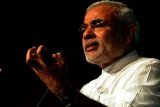ONS UK immigration stats: Government target of 100,000 not achieved

Estimated net migration to the UK in 2011 was 36,000 lower from 2010 (252,000) and the total long-term immigration was also slightly lower when compared to 591,000 in 2010. But the long-term immigration number has remained broadly at a similar level since 2004.
The report noted that citizens from non-EU countries continued to be the largest group of migrants to the UK compared. An estimated 314,000 non-EU citizens including Indians arrived to live in the UK in the year to December 2011. This constituted 55% of the total number of immigrants.
In 2010, around 322,000 non-EU citizens came to the UK.
Estimated net migration was 216,000 in the year to December 2011. This is lower, but is not a statistically significant difference, from 252,000 in the year to December 2010, according to the ONS.
UK immigrations statistics 2011 factsheet (All figures are estimated and are taken from the ONS report)
|
More like this
The migration statistics demonstrate the folly of the Government's target to reduce net migration to less than 100,000 a year, according to the IPPR (institute for Public Policy Research) in the UK.
While the 2011 immigration numbers are slightly lower that the 2010 figures, the fall is not statistically significant, it noted.
“The statistics show that the government remains a long way from its goal,” said Sarah Mulley, associate director at IPPR.
Recent visa data has suggested that further declines in immigration may be achieved especially as the number of student visas issued has fallen.
“But even reductions on this scale seem unlikely to be enough to get net migration under 100,000, not least because student migration is mostly short-term, which means that reduced immigration now leads to reduced emigration later, drastically reducing the impact on net migration after the first year or two,” Mulley said.
“If the target is missed, public confidence in the immigration system will be further undermined, making the politics of migration in the UK even more ugly than it is already,” she added.
The IPPR also attacked the government’s strategy of reducing net migration at significant economic cost to the country – that is by reducing the numbers of skilled migrants who come to the UK to work hard, pay taxes, help businesses grow, and staff our public services, as well as fee-paying students who support our colleges and universities and provide jobs for thousands, Mulley added.
Most read
- 2017: Full list of Indian States, capitals and their Chief Ministers
- As the venerated former President APJ Abdul Kalam passes away, here's a list of all Presidents of India
- List of all the major rivers of India: Names, Origin and Length
- Indian cabinet 2017: Full list of Ministers and their portfolios in Narendra Modi government
- Dosa recipe: How to make crispy Paper Dosa and Masala Dosa
- Recipe: Misal Pav – how to make missal masala, usal and tarri
- Watch Delhi bride Amisha Bhardwaj’s funky wedding dance video that is now globally viral
- Bollywood Dream Team 2016: Katrina, Alia, Sidharth, Varun, Parineeti, Aditya Roy Kapur US tour in August
- Commonwealth Games 2014: Full list of Indian gold, silver and bronze medal winners
- SIIMA Awards 2015 Red Carpet Pics: Trisha, Shruti Hassan, Amy Jackson, Rana Daggubati, Hansika dazzle
India News Bulletin by email
More Lead Stories
- London Grenfell Tower Fire – Key facts and pics
- Cannes 2017 Photos: Bollywood’s Deepika Padukone, Aishwarya Ra Bachchan Impress
- Sizzling Deepika Padukone’s special appearance in Raabta title song trends even before release
- Finally! The official trailer of Sachin - A Billion Dreams, on India’s beloved Master Blaster
- Parineeti Chopra’s debut song in Meri Pyaari Bindu shows how multi-talented she is!













